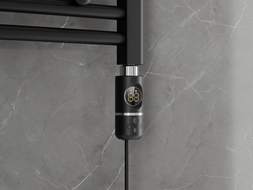
The comfort of using a bathtub is influenced by its quality, shape, and height of the edge. There is no fixed, rigid size for this dimension. The comfortable height of a bathtub will differ for a shorter person compared to a taller one, although the standard height most commonly used is 60 cm. This dimension is measured from the floor to the upper edge. Importantly, bathtubs available in stores typically measure between 40 to 50 cm. The above parameters are characteristic of free-standing units.
Optimal Height of Bathtub Installation from the Floor
When selecting a bathtub of a certain height for your bathroom, one cannot forget about the important factor of the height of the feet. They can usually be adjusted between 12 to 18 cm. In some cases, lowering the height of the bathtub is achieved by calibrating them or by a wider installation of the bathtub and creating steps. A siphon is then used which is led into a recess in the ceiling. It is also common to see a solution involving raised installations. In such cases, the legs of the bathtub and its lower parts are embedded into the structure and are not visible to the eyes, which makes the bathtub appear very low and accessible. Importantly, and indeed most importantly when installing a bathtub, the height of the bathtub should be adapted to the height of the household members.
Different floor levels in the bathroom have plenty of advantages. A bathing area on a platform looks extremely majestic and elegant. It fits well in bathrooms designed in a Scandinavian style. This minimalist solution, however, is not at all simple to implement. Although the bathtub looks very impressive, one should be cautious with such a solution - steps with water can be slippery - such a wet surface on an elevation is not safe for the elderly and children. While entering the bathtub itself is not a difficult task, exiting onto the raised surface after bathing may require more strength and physical agility.
Bathtub in the Floor - What to Consider?
A good solution is a bathtub installed in the floor. Here, the height of the bathtub is quite considerable, and additionally, there are steps involved. This solution is meant for stable ceilings. It is usually applied on ground floors and on upper floors with a ceiling that guarantees sufficient load-bearing capacity. All works related to the installation of floor-level bathtubs should be consulted in the presence of an architect or constructor. Only then, after confirming the safety of such a solution, can one decide to proceed. Moreover, the connections to the bathtub are usually run just below the ceiling, so additional construction may be required to hide them beneath the plaster, and one must also take into account that the ceiling in the bathroom will be lower.
It is more convenient to install such a bathtub on the ground floor, especially when the house is directly on the ground (building technique on the ground). What should you start with?
- You need to excavate a pit about 80 cm deep.
- The excavation is filled with concrete and a waterproof insulating layer is laid, as well as thermal insulation.
- Typically, hard Styrofoam works well for this purpose.
This solution also has its limitations. A bathtub installed in this way does not provide easy access to the siphon, and proper approach is necessary - a maintenance inspection chamber will thus be essential. A bathtub in the floor is undoubtedly the most visually impressive option, but one should remember that it requires adequate space. Although it looks unique, it is worth noting that it is not very practical - getting out of it will be difficult, as will getting into the bathtub on a wet surface.
Optimal Height of Bathtub Enclosure Must Fit the Entire Arrangement
When selecting a bathtub that does not fall under standard height and which will be installed on the floor, it is worth remembering that the height will equal that of its enclosure. This should be taken into account when determining the amount of materials needed to create the frame and cover it with tiles. In the case of enclosures made of concrete blocks, one can count on their durability and resilience. A significant advantage is that they are resistant to all kinds of damage and offer high acoustic insulation. Another advantage is the heat accumulation. They allow the water in the bathtub to retain its heat as it gradually releases it. This solution is intended for simpler bathtubs, usually slightly lower.
In the case of tall rectangular bathtubs with rounded shapes, it is recommended to use enclosures provided by the manufacturer, specifically designed for a given model. This solution ensures that the user does not have to worry about selecting the appropriate amount of materials to fully enclose the height of the bathtub, since the enclosure walls will be measured accordingly in advance. The height of the bathtub influences the comfort of its use, so before arranging the space in the bathroom, it is simply advisable to try out the specific chosen model of the bathtub.



















